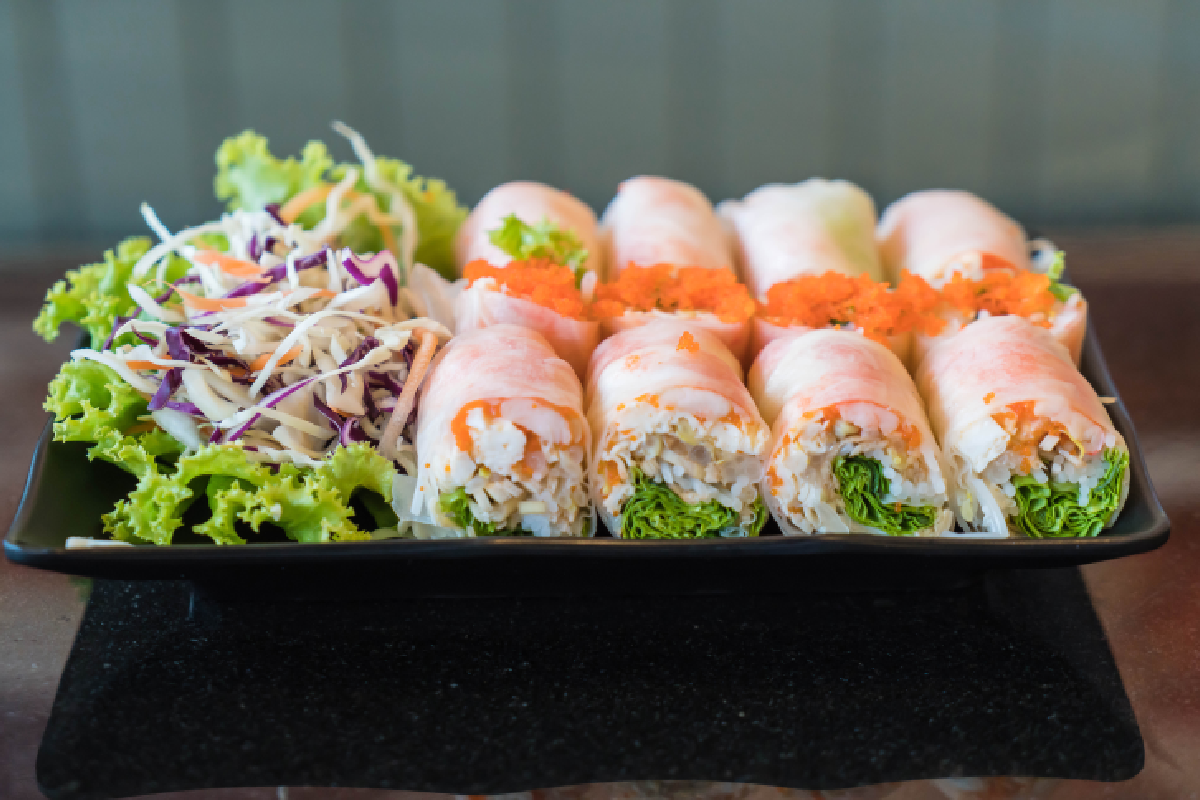Understanding Boston Rolls
What Makes a Boston Roll Unique?
The Boston roll is a delightful twist on the traditional sushi roll, embodying the spirit of innovation that sushi embodies. Crafted with succulent shrimp, creamy avocado, and crisp cucumber, this roll is wrapped in a blanket of vinegared rice and nori (seaweed), then often topped with a sprinkle of roe for an extra flavor pop. What sets it apart is the use of poached shrimp, a nod to Boston’s rich seafood culture, distinguishing it from its sushi counterparts that commonly feature raw fish.
Crafting the Perfect Boston Roll
Preparing a Boston roll requires a delicate balance of flavors and textures. The shrimp is poached to perfection, ensuring it’s tender and juicy. The avocado and cucumber are sliced thinly, adding a creamy crunch that complements the shrimp’s sweetness. When rolling, precision is key to achieving the roll’s signature look, with the rice on the outside gently pressed to hold the filling in place.
Key Differences Between Boston Rolls and California Rolls

Ingredients and Flavor Profile
At the heart of the distinction between Boston rolls and California rolls lies in their unique ingredients and the resulting flavor profiles. The Boston roll, with its tender shrimp, crisp cucumber, and creamy avocado, offers a sweet and slightly oceanic taste, complemented by the subtle tang of the vinegared rice. This roll leans heavily on the freshness of its seafood component, celebrating the rich seafood tradition of its namesake city.
In contrast, the California roll, with its imitation crab, avocado, and cucumber, wrapped in sushi rice and often sprinkled with sesame seeds or roe, presents a more complex flavor. The imitation crab provides a sweet and savory taste that, when combined with the creaminess of the avocado and the crunch of the cucumber, creates a satisfying textural and taste experience. This roll’s flavor is a nod to the innovative spirit of California, making sushi accessible and enjoyable to a broad audience.
Preparation Techniques
Another distinct difference is in their preparation. The California roll is an “inside-out” roll, meaning the rice is on the outside, a technique that was revolutionary at the time of its creation. This not only alters the roll’s texture and appearance but also its taste, as the rice’s slight sweetness becomes more pronounced.
The Boston roll, while more traditional in its seaweed-on-the-outside presentation, distinguishes itself through the use of poached shrimp, a method that requires precise timing to ensure the shrimp’s tenderness and flavor are maximized. This attention to the seafood component underscores the Boston roll’s homage to New England’s seafood excellence.
Cultural Significance and Popularity
Culturally, both rolls have played significant roles in introducing sushi to the Western palate, each in its own unique way. The California roll, with its inside-out structure and use of imitation crab, broke down barriers for those hesitant about trying raw fish, thereby paving the way for the explosion of sushi’s popularity in the West.
The Boston roll, on the other hand, celebrates the abundance of local seafood while offering a sushi option that is both approachable for beginners and satisfying for sushi veterans. Its popularity extends beyond Boston, highlighting the universal appeal of combining traditional sushi techniques with local flavors.
In essence, the Boston and California rolls serve as delicious ambassadors of sushi, each telling its own story of cultural adaptation and culinary innovation. Through their differences in ingredients, preparation, and cultural significance, they have contributed to the global tapestry of sushi cuisine, inviting diners everywhere to explore the rich diversity of this Japanese art form.
Nutritional Comparison

When delving into the nutritional content of both the Boston roll and the California roll, it’s evident that each offers a mix of health benefits, making them not only a treat for the taste buds but also a decent choice for a balanced diet. Let’s break down the nutritional aspects of these popular sushi rolls.
Caloric Content and Health Benefits
The California roll, typically made with imitation crab, avocado, and cucumber, is a relatively low-calorie option, with an average roll containing about 250 to 300 calories. The inclusion of avocado brings in healthy fats, specifically monounsaturated fats, which are beneficial for heart health. Additionally, the cucumber adds a hydrating element and dietary fiber, aiding in digestion.
On the flip side, the Boston roll, featuring shrimp, avocado, and cucumber, also falls in a similar calorie range, making it another health-conscious option. Shrimp, the star ingredient, is a great source of protein and provides a variety of vitamins and minerals, including selenium and vitamin B12, essential for maintaining energy levels and supporting the immune system.
Dietary Considerations
For those watching their carbohydrate intake, it’s worth noting that both rolls contain sushi rice, a refined carbohydrate. However, the fiber from the avocado and cucumber can help balance this out, making these rolls a moderate option in a balanced diet.
Moreover, the Boston roll‘s shrimp offers a lean protein alternative to the more common raw fish found in sushi, making it an excellent choice for those looking to increase their protein intake without significantly raising calorie consumption. The California roll, with its imitation crab, provides a lower protein content compared to rolls made with real crab or fish, but it still remains a viable option for those seeking a lighter, yet satisfying, sushi experience.
FAQs
In the realm of sushi, the Boston roll and California roll frequently spark curiosity among enthusiasts and beginners alike. Here are some of the most commonly asked questions, demystifying these popular sushi selections.
Why is the Boston roll called so?
The Boston roll earns its name from its star ingredient, shrimp, a nod to Boston’s rich history as a seafood hub. Unlike traditional sushi that often features raw fish, the Boston roll’s use of cooked shrimp caters to a broader audience, including those hesitant about eating raw seafood. This culinary creation embodies the essence of Boston’s seafood tradition, marrying it with the art of sushi.
Can California rolls be considered authentic sushi?
While purists might argue that the California roll, with its inside-out rice presentation and use of imitation crab, strays from traditional sushi, it holds a place of honor in the world of sushi for its role in popularizing the cuisine outside Japan. Its invention was a creative response to Western preferences, making sushi accessible to a wider audience and serving as a bridge to more traditional sushi experiences.
Are Boston rolls or California rolls better for beginners?
Both rolls are excellent choices for those new to sushi. The California roll, with its mild flavors and absence of raw fish, offers a gentle introduction to sushi. Similarly, the Boston roll‘s use of cooked shrimp can be more palatable for beginners than raw fish, easing them into the diverse world of sushi with familiar textures and flavors.
How do chefs decide on the roll variations to offer?
Sushi chefs often curate their menu based on a combination of traditional sushi practices and the tastes of their local clientele. Innovations like the Boston and California rolls arose from a desire to adapt traditional sushi to suit local preferences and ingredients, showcasing the chef’s creativity and understanding of their audience’s palate.
These FAQs peel back the layers of curiosity surrounding the Boston and California rolls, offering insights into their origins, appeal, and place in the sushi pantheon. Whether you’re a sushi novice or a seasoned connoisseur, understanding these nuances enriches the dining experience, inviting a deeper appreciation for the art of sushi.
Conclusion and Personal Recommendations
As we wrap up our exploration of the Boston roll and California roll, it’s clear that both have carved out distinctive niches within the sushi world. Each roll, with its unique blend of ingredients and flavors, serves as a testament to sushi’s versatility and its ability to adapt to different cultural tastes and dietary preferences.
Summary of Differences
The journey from the origins to the preparation and nutritional aspects of these rolls highlights the creativity inherent in sushi making. The Boston roll, with its emphasis on cooked shrimp, caters to those who prefer the taste and texture of cooked seafood, while still offering a window into the sushi experience. The California roll, on the other hand, stands as a pioneering creation that introduced sushi to a broader Western audience, thanks to its inside-out rice technique and the use of imitation crab.
Personal Taste Preference Insights
From a personal standpoint, the choice between a Boston roll and a California roll might boil down to individual preferences for ingredients and the allure of trying something new. For those who enjoy the sweetness of shrimp and the rich seafood tradition it represents, the Boston roll is an excellent choice. Meanwhile, the California roll offers a unique flavor profile that combines the creaminess of avocado with the savory taste of imitation crab, making it a perennial favorite for those seeking a sushi experience that balances familiarity with innovation.
In the end, both the Boston and California rolls stand as delightful entry points into the vast and varied world of sushi. They embody the spirit of culinary exploration, bridging traditional Japanese sushi with global tastes and preferences. Whether you’re drawn to the Boston roll’s seafood charm or the California roll’s innovative flair, each offers a unique way to enjoy sushi, encouraging diners to dive deeper into this exquisite cuisine.
As we continue our culinary adventures, let’s remember that sushi, in all its forms, invites us to explore, taste, and appreciate the subtle complexities of flavors and textures. So, the next time you find yourself perusing a sushi menu, consider embarking on a taste journey with either a Boston or California roll – or, better yet, both – and savor the rich tapestry of ingredients and stories they bring to your plate.
And there you have it—a deep dive into the delicious worlds of Boston and California rolls, their nuances, and their place in the grand sushi mosaic. Whether you’re a seasoned sushi aficionado or a curious newcomer, these rolls offer a gateway to the diverse and flavorful universe of sushi. Happy dining!

